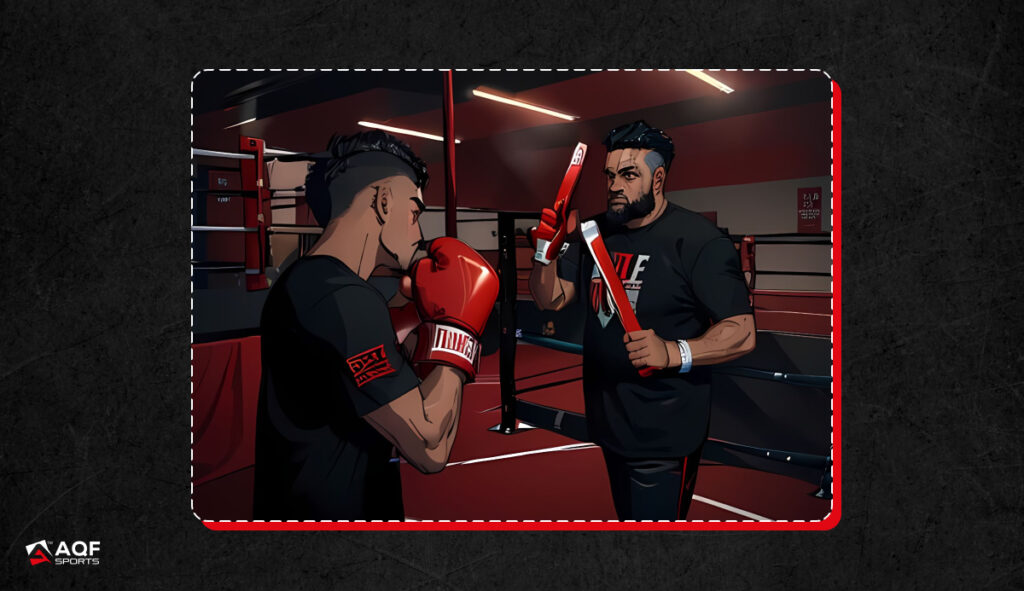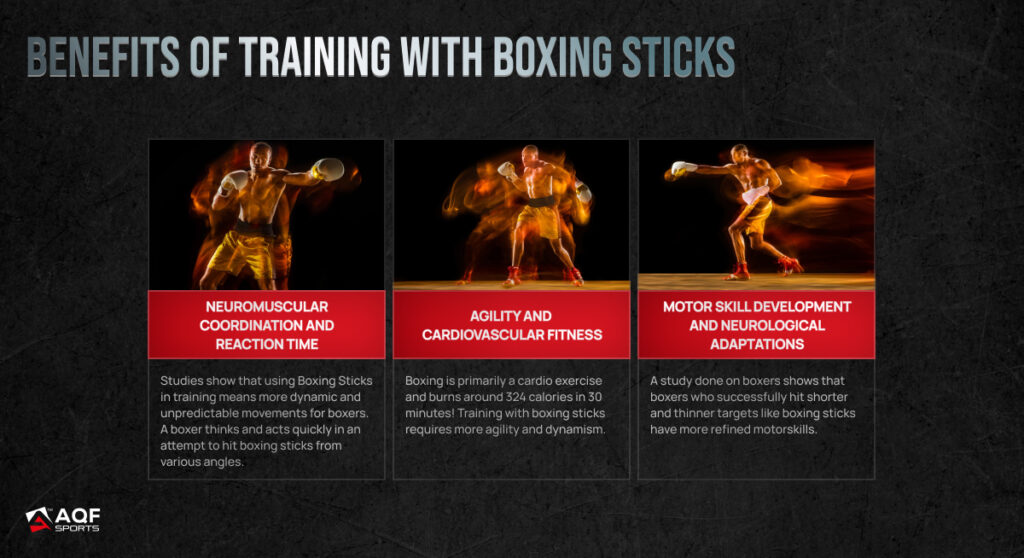Precision Boxing Training Sticks – Do They Work? [Complete Guide]
![Precision Boxing Training Sticks - Do They Work? [Complete Guide]](https://blog.aqfsports.com/wp-content/uploads/2023/08/image1.jpg)
Ever found yourself questioning your punching technique and whether your punches are impactful enough to knock out your opponent?
All boxing learners can relate to the crippling feeling of doubting your technique. The frustration is real and impedes our progress.
Here is a way out: Precision boxing training using boxing sticks. Conventional focus pads may not provide the same level of dynamism needed to simulate unpredictable moves in the ring.
However, practising your punches on boxing sticks enhances your precision, improves coordination and boosts your stamina.
In this blog, we will find out:
- Do boxing sticks really work?
- Best way to hold and train with boxing sticks
- Things to look for in boxing training sticks
So if you are ready to throw precise punches that knock your opponent right out, read till the end.

What are Boxing Sticks?
“Boxing Sticks” are specialized boxing and combat sports training tools. These innovative devices introduce a new level of boxing skill development.
Trainers and coaches use Boxing Sticks as an alternative to conventional focus mitts to enhance a boxer’s technique, precision, speed, and coordination.
Your training partner or coach can use boxing sticks during training sessions. Precision boxing sticks are elongated, cylindrical pads with handles attached at the base.
The trainers manoeuvre boxing sticks to simulate defensive and offensive movements to improve boxer’s reaction time and accuracy during a training session.
Purpose and Benefits of Boxing Sticks:
- Boxing Sticks challenge boxers to adapt to dynamic and unpredictable boxing scenarios
- Boxing sticks require more precise punches and well-timed combinations
- Fast-paced Boxing Stick training boosts stamina, endurance, and physical fitness.
- Boxers use sticks to practice evasive manoeuvres, footwork, and defensive techniques
Boxing Sticks Vs Conventional Focus Mitts:
Boxing Sticks are an advanced alternative to traditional focus mitts because
- Boxing sticks allow for several punch variations and angles during boxing simulations
- Boxing Sticks offer more lifelike boxing experience and prepare boxers for unpredictable bouts
- The elongated boxing stick pads challenge boxers to improve their coordination and response time
So if you want to improve your boxing ring performance and overcome your self-limitations, boxing sticks are an ideal training tool.
Do Boxing Sticks Really Work?

Sports Science Says that:
Boxing sticks are more than just a gimmick – they are modern training tools designed to simulate real-life boxing movements.
Neuromuscular Coordination & Reaction time:
Studies show that Boxing Sticks in training mean more dynamic and unpredictable movements for boxers.
A boxer thinks and acts quickly to hit boxing sticks from various angles.
This significantly enhances the boxer’s neuromuscular coordination, reaction time, and agility. [1]
Agility and Cardiovascular Fitness:
Boxing is primarily a cardio exercise and burns around 324 calories in 30 minutes! [2]
Training with boxing sticks requires more agility and dynamism.
The increased boxing intensity means more aerobic respiration, elevated heart rate, more precipitation and ultimately more stamina.
Motor Skill Development & Neurological Adaptations:
Holding boxing sticks in both hands adds a new challenge in conventional boxing training.
A study done on boxers shows that boxers who successfully hit shorter and thinner targets like boxing sticks have more refined motor skills.
The study also found that coordination agility, arm and shoulder muscle strength, upper extremity speed, explosive limb strength, and placement precision were significant motor skills differentiating boxers of varying competitive success levels. [3]
How to Hold a Boxing Stick: Step-by-Step
Step 1: Get a Good Grip:
- Hold the boxing stick with a firm yet relaxed grip. Wrap your fingers comfortably around the handle, and place your thumb on top.
Step 2: Position Your Hand:
- Keep your wrist straight and aligned with your forearm. Hold your hand at a comfortable distance from the base of the handle for better control.
Step 3: Keep Your Arm Relaxed:
- Bend your elbow slightly to maintain a relaxed arm position. This helps you control the stick without straining your muscles.
Step 4: Stand Sideways:
- Stand sideways facing the person holding the stick. This stance lets you react effectively to movements and practice your punches and defence.
Step 5: Watch the Stick:
- Keep your eyes on the boxing stick and your training partner. This helps you anticipate the stick’s movements and react quickly.
Step 6: Stay Light on Your Feet:
- Stay on the balls of your feet and gently bounce. This allows you to move easily and pivot while staying alert.
Step 7: Respond to Movements:
- React naturally as your partner moves the stick. Practice your punches, dodges, and slips according to the stick’s motion.
Step 8: Aim Accurately:
- Focus on hitting specific areas of the stick as it moves. This improves your punch accuracy and targeting skills.
Step 9: Breathe Steady:
- Maintain a steady and rhythmic breathing pattern. Proper breathing keeps you relaxed and focused during training.
Step 10: Increase Intensity Gradually:
- Start with slower and controlled movements, gradually picking up speed and intensity as you become more comfortable.
Step 11: Talk to Your Partner:
- Communicate with your partner about the punches, combinations, and defence moves you’ll practice. This ensures a coordinated and effective training session.
- If training with a partner, take turns holding the stick. This lets both of you practice and improve your skills.
How do You Use a Boxing Stick?

Warm Up & Get Ready:
Use the right Boxing Sticks and wear your boxing gloves for protection.
Do light warm-up exercises and stretches to loosen up your muscles.
Find a Partner
Find a friend or coach to hold the Boxing Sticks. Stand facing them with some space to move around.
Chat with your partner about which punches you’ll practice and agree on how hard you’ll go.
Get in Position:
Stand with your feet about shoulder-width apart, slightly bend your knees and lift your fists up near your face.
Now, Punch!
Begin with simple punches, like jabs and straights. Your partner moves the Boxing Sticks like a moving target.
Try out different punch combinations, like a jab followed by a cross. The sticks help you work on timing and accuracy.
Move and Dodge:
Practice moving around and dodging the sticks, like you’re avoiding punches. This helps with your footwork and defence.
Practice Footwork:
Add footwork by circling around your partner and turning as you punch. It makes the training more realistic.
Ask your partner to move the sticks unpredictably while you practice quick reactions. This helps you get better at reading your opponent’s moves.
Mix it Up and Keep Practicing:
Stay active with lots of punches and dodges. It’s great for your fitness and stamina.
Cool Down:
Finish up with some stretches to relax your muscles and cool down your body temperature.
Learn and Improve:
Talk to your partner or coach after the session. Get feedback on what you did well and how you can get even better.
Boxing Sticks Vs Paddles – Pros & Cons
Many top coaches agree that the choice between the two often boils down to personal preference. Both tools offer unique advantages that cater to different boxing training aspects.
Let’s explore the pros and cons of each:
Boxing Sticks:
Pros:
- Defensive Skills: Sticks let you practice dodging and slipping safely.
- Hit Without Getting Hit: Learn to land punches while avoiding hits.
- Safe Practice: Sticks are safer for both boxers and coaches.
Cons:
- Softer Punches: The foam surface might reduce punch intensity.
- Less Realistic Impact: Sticks don’t feel exactly like hitting a target.
Uncover More: How to Punch Harder? Mistakes to Avoid & Tips to Follow
Boxing Paddles:
Pros:
- Stronger Punches: Paddles let you throw harder punches, which can help build power.
- Realistic Target: They feel like hitting a real opponent, improving accuracy and impact.
- Easy to Carry: Paddles are compact and fit easily in your boxing bag.
Cons:
- Limited Movements: Paddles might not mimic all angles and movements.
- Possible Injury: There’s a small risk of injury due to the solid surface.

Expert Tips: What to Consider When Buying a Boxing Stick
These expert insights will help you buy the best boxing stick for your sessions:
Foam Padding Density:
Opt for a boxing stick with foam padding that strikes a balance between firmness and softness. It should offer realistic resistance to punches while also being pliable enough to absorb impact, ensuring both safety and an authentic training experience.
Realistic Surface Texture:
Look for a stick with a target surface featuring diverse textures. These textures replicate hitting different areas of an opponent’s body, enhancing punch accuracy and adaptability to various striking points.
Ergonomic Handle Design:
Prioritize a stick with an ergonomically designed handle that guarantees a secure and comfortable grip. A well-designed handle not only bolsters control and reduces fatigue but also encourages proper wrist alignment to prevent strain.
Even Weight Distribution:
Choose a stick with weight evenly distributed along its length. This uniform weight distribution facilitates consistent handling and manoeuvrability during drills, enabling you to execute a range of punches and movements fluidly.
Reinforced Stitching:
Inspect the seams and stitching around the padding. Durable, reinforced stitching prevents the foam from shifting, ensuring prolonged stick integrity and maintaining its shape over time.
Durable Leather Build:
Choose a boxing stick constructed from robust and long-lasting materials. A resilient outer layer guarantees the stick’s structural integrity and functionality even after extensive use.
Shock Absorbing Inner Core:
Consider a stick with an advanced inner core designed for enhanced shock absorption. This feature minimizes vibrations and reduces strain on your joints and muscles, promoting a safer and more comfortable training session.
Secure Strap Design:
Inspect the strap design for secure and adjustable fastening. A well-designed strap ensures the stick remains firmly attached to the holder’s hand throughout training, promoting stability and effective drills.
References:
[1] Innovative Methods in Boxing Training – Source
[2] Boxing Fitness – EverydayHealth
[3] Comparative analysis of motor skills in boxers – Source






